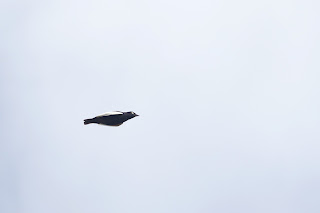We had to return the car we had hired in the evening, and we would then be taking the coach overnight to Sao Paulo, thus ending our travels in Brazil until I return at the end of the year. We did not need the car on this day, but it allowed us to do a few things in Vitoria.
We spent
the morning with a friend of Ed’s who lived in the city. He took us to a small
feeding station he had set up, which had a few nice bits including a very confiding
pair of Blonde-crested Woodpeckers and a nice pair of Straight-billed Woodcreepers.
In the mangroves adjacent there was also a Yellow-crowned Night-Heron and a few
Bicolored Conebill were whizzing around.
He told us about
a spot to try in the afternoon for Oystercatcher. Although this is obviously
not a rare bird we did not have anything else to do, so after a visit to a
turtle sanctuary after lunch, we headed there. And we had a lovely afternoon.
Not only did we count 161 American Oystercatchers roosting together extremely
close, but there was also a summer plumaged Spotted Sandpiper. And offshore
there were a few Brown Booby, Cayenne Tern and impressive numbers of Green Sea
Turtles, with at least five different individuals. It was an absolutely
splendid way to round off our travels before we return to the big city.
Vitoria: Feral Pigeon, Picazuro Pigeon, Ruddy Ground Dove, Grey-cowled Wood Rail, American Oystercatcher, Semipalmated Plover, Spotted Sandpiper, Royal Tern, Cabot's Tern, Magnificent Frigatebird, Brown Booby, Snowy Egret, Little Blue Heron, Yellow-crowned Night Heron, Black Vulture, Turkey Vulture, Roadside Hawk, Blond-crested Woodpecker, Crested Caracara, Yellow-headed Caracara, Straight-billed Woodcreeper, Masked Water Tyrant, Great Kiskadee, Tropical Kingbird, Southern Rough-winged Swallow, Tropical Mockingbird, Pale-breasted Thrush, Creamy-bellied Thrush, House Sparrow, Purple-throated Euphonia, Red-cowled Cardinal, Sayaca Tanager, Palm Tanager, Blue Dacnis, Bicolored Conebill, Saffron Finch, Bananaquit,























































